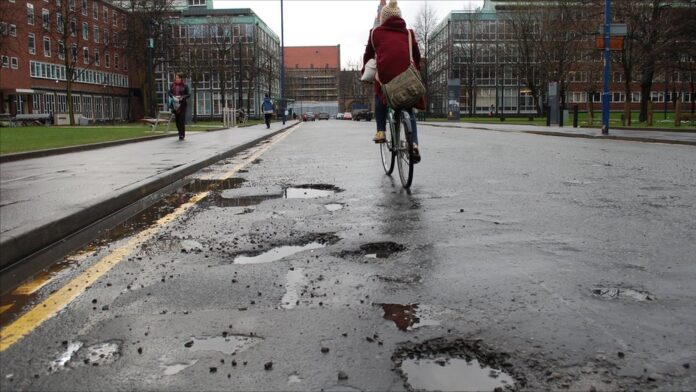As advocates of National Bike Week 2021 (30th May – 5th June) encourage people across the UK to rethink their everyday journeys and switch to cycling, personal injury specialists at JMW Solicitors are highlighting the staggering number of potholes currently littering Greater Manchester’s roads.
The combined total size of potholes in Greater Manchester towers above some of the region’s tallest skyscrapers, according to research carried out by personal injury specialists at JMW Solicitors, causing safety concerns for the area’s growing cycling community.
The cycling injury team at the Manchester-based law firm conducted research into data provided by fixmystreet.com, which revealed there are currently more than 7,114 reported open pothole cases in the region. A single pothole is defined as any defect with a depth greater than 40mm; however, when added together, this gives a combined minimum depth of 284.6m.
This means that, when combined, the depth of the potholes is deeper than the height of some of Manchester’s tallest and most recognisable buildings, including Deansgate Square South (200.5m), Beetham Tower (168.9m) and Deansgate Square East Tower (157.9m).
Nadia Kerr, Head of JMW Solicitors’ Cycling Injury department, said: “Potholes can cause serious life-altering injuries to road users, in particular cyclists and motorcyclists. It is vital that these road defects are repaired to allow road users a smooth journey. Unlike motorists, cyclists and motorcyclists who come across a pothole cannot simply go through it as this will most likely force them off their bike. Also, they cannot always swerve around them easily in case they find themselves in the path of traffic.
“While there has been an increased presence of roadworks repairing potholes whilst roads have been quieter as a result of the coronavirus pandemic, not enough is being done to prevent the number of potholes increasing. Councils should be conducting regular checks to identify any potential hazards and ensure defects are repaired properly within a reasonable amount of time.
“If the council fails in their duty to maintain and repair roads and pavements, and someone suffers an injury due to a pothole or other road defect, they are entitled to make a claim for the pain and suffering it causes.”
It is the local council’s responsibility to maintain the roads in their area so that cyclists, motorcyclists and other road users can travel safely. This is a legal obligation as stated in Section 41 of the Highways Act 1980.
As a keen cyclist and cycling accident solicitor, Nadia waged a nine-month campaign against Manchester City Council about a single pothole to help protect fellow commuters from the road defect. The pothole, located on Upper Chorlton Road in Manchester, was deep, large and dangerous, which could have resulted in serious harm to a cyclist should they have hit it.
Following five complaints, a barrage of social media posts and a request made under Section 56 of the Highways Act, the pothole was finally filled in. Since sharing her story on social media, Nadia has been inundated with pothole complaints and cases from concerned commuters.
Nadia Kerr said: “As a concerned member of the public, a campaigner for road safety and active travel, and a cycling accident solicitor, I was determined to keep trying to get this defect filled. But this is just one pothole in one local authority area, and there are thousands more across the region.”
The number of reported open potholes cases in Greater Manchester increased by almost 5%, from 6,783 in 2019 to 7,114 in 2020. The worst affected region, Manchester city centre, saw almost a 6% increase over the same period, from 2,228 to 2,356.
Since JMW started to report on the number of potholes in Greater Manchester in 2018, the overall number of potholes in the region has increased by one third, from 5,341 in 2018 to 7,114 in 2020.
“This is not good enough,” said Nadia.







